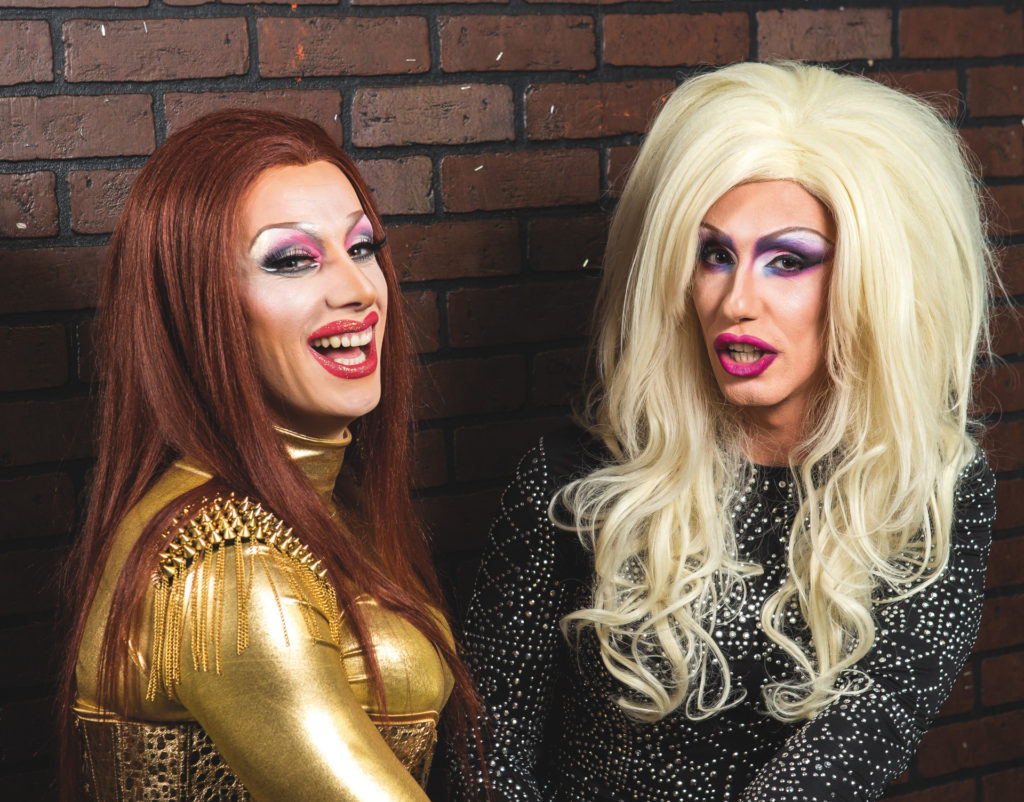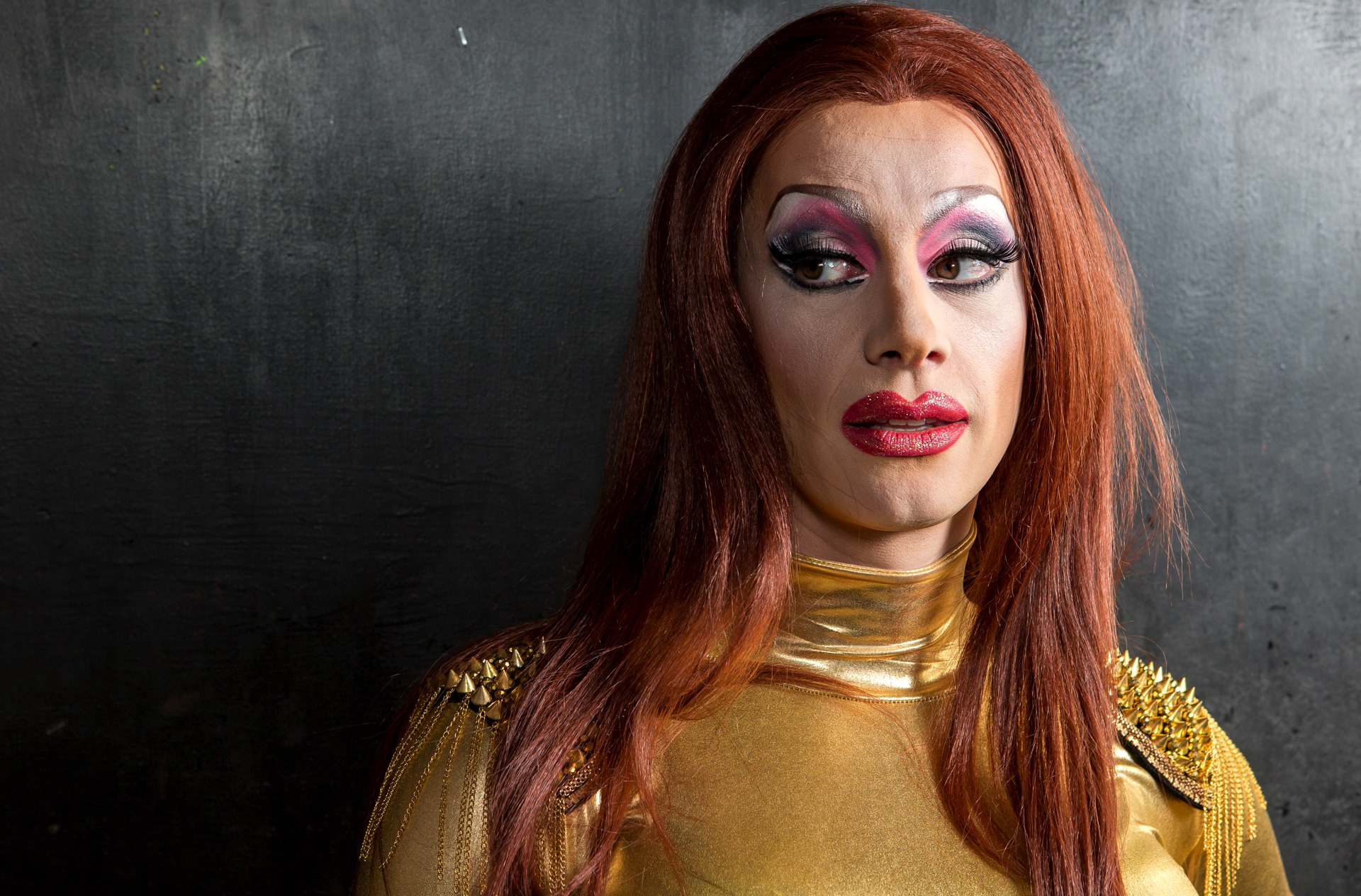Behind the queens
Manchester has a long history of drag, going back to the drag balls of the 19th century. But inspired by RuPaul’s Drag Race the north’s new acts are more innovative and challenging
First he was accosted in the toilets. Then he was heckled off the stage. Michael Atkins’ first attempt at drag at a Manchester gay club was challenging to say the least.
“I was booed off stage for taking my clothes off,” he remembers. “I exercised a lot. Earlier that night, somebody pulled me over in the toilet, unbuttoned my dress and said: ‘You don’t need to do this.’ It inferred the only people who do drag are unsuccessful men.
“In the gay scene, you’re either a fit, butch masculine man or a twink or a drag queen. He was saying I didn’t need attention as the latter because I could get it in another way.
“That made me uncomfortable and drove me to grow my drag in a way that was about confusing what was seen as beautiful.”
Drag Race has brought shade-throwing and lip-synching into the mainstream
The jeers have now been silenced. As Cheddar Gorgeous, Atkins, alongside “shock in a frock” Anna Phylactic and DJ Danny Olsson-Lane, founded monthly night Cha Cha Boudoir in 2013. Showcasing the fiercest queens in a city it’s become renowned as a wellspring of drag talent – to the point where Dazed and Confused asked: “Is Manchester the drag scene’s new New York?”
Walk around Manchester and you can witness a variety of different drag styles. Traditional ribald stalwarts like Viva La Diva, Belinda Scandal and Nana – purportedly the oldest queen in the village – belt out show tunes and sling double entendres around. There’s avant-garde cabaret at A Queer Revue and club kids at Pop Curious? The transgressive Grace Oni Smith, a woman who was born a man who performs as a man dressed as a woman, hosts the night Drunk at Vogue.
Neighbouring Salford even boasts its own Drag Lab at creative hub Islington Mill, a dedicated space where queens create new costumes and develop their material.
Inspired by NY nightlife maven Ryan Burke, Peaches Christ and subversive notions of “genderfuck” – challenging conventional notions of masculinity and feminity – Atkins, 33, has been in Manchester for 10 years now. His looks are elaborate, surreal, thought-provoking and absurdist.
“Part of me goes: ‘We’re better than New York,’” he laughs. “What’s strong about the Manchester drag scene is the incredible queer heritage we have. What grows from that is diversity and an emphasis on doing things our own way. Which, in Manchester, is every way.”
Manchester has an illustrious history of drag, going back to the infamous Hulme Drag Ball of 1890, taking in Foo Foo Lammar – the drag queen from the tough east side of the city who died in 2003 – and the Flesh club nights at the Haçienda in the early 1990s. A new generation of performers have picked up the baton.
“There’s drag queens everywhere in Manchester now,” says Daniel Wallace, aka Anna Phylactic, whose face towers over the city’s gay heroes, including Alan Turing and Quentin Crisp, on a 40ft mural in the Gay Village. “More so than customers to be honest!”
The proliferation of drag in Manchester follows an international trend. The popularity of RuPaul’s Drag Race has brought shade-throwing and lip-synching to the mainstream. Drag argot like “serving realness” and “slay queen” are now commonplace in conversation.

“I’m always surprised when straight guys ‘Yass!’ [used to express delight] at me or even when you see girls contouring – a make-up trend that originated in drag,” reflects Wallace, 35, who cites playing the leader of the fairies in the school panto as his first experience of drag. “There’s footage of me kicking off with the director because my white tights went missing and the brown replacements didn’t match my tutu! My first diva fit!”
Rather than being a female illusion, Wallace draws influence from the 1980s Blitz Kids – he even acted in the Boy George biopic Worried About The Boy – and the 1990s Michael Alig-led Club Kids. These glamorous references are fashionable now, he points out, in contrast to a decade ago. “Remember all those nights called Scally Bender? It was all very Shameless-infused. It was cool to turn up to a club in trackies and a cap and be as macho as possible. Drag was definitely downplayed.”
The rise of drag reflects how the equality fight has moved on post-gay marriage. After years of arguing that gay men were just the same as heterosexuals and non-threatening, there’s now the confidence to actually further aspects of queer culture – including those that may threaten mainstream acceptance or perpetuate stereotypes. “The hyper-masculine men are now being left behind,” says Atkins.
Whereas our drag is steeped in bawdy music hall traditions, Drag Race was different. Alongside genderfuck, the US show introduced drag pageantry, modelled on traditional beauty pageants. The focus on transformation or female illusion – padding, tucking and contouring – was very different to what we traditionally had in the UK.
Anna Phylactic and Cheddar Gorgeous have also adopted a version of the drag family model seen in the US – where drag mothers would care for sometimes homeless kids who’d fled to the cities after being shunned by their biological relatives – but rare in the UK. The political aspect to US drag culture goes back at least to 1969, when the Stonewall Riots were sparked by three drag queens and a lesbian being dragged into a paddy wagon by the NYPD.
Formerly known as Sisters Gorgeous, Anna Phylactic and Cheddar Gorgeous provided mentorship to younger queens Liquorice Black and Violet Blonde, forming the Family Gorgeous with Grace Oni Smith, Lill Queen and Miss Blair.
“Queer kinship works differently over here,” notes Aktins. “Gay people in America were shoved into ghettos where those relationships were integral to survive. We didn’t use the terminology lightly – we have expectations of each other.”
“Drag daughter” Liquorice Black’s persona is like a 1920s silent film star mixed with Morticia Addams and Elvira. “It stands out in a club and pictures because everyone’s so colourful and vibrant,” says the 24 year old, who also intricately constructs accoutrements for other queens. “I originally just wanted to be an arty club kid but it evolved into drag.
“More time goes into making everything than people expect – an outfit can take two months. When I first went out in a dress, it wasn’t this big liberating moment. I felt awkward and had to slowly chip away at it.”
Violent Blonde’s style is tranimal – an exploration of the grotesque. “The first time I did drag, it felt powerful to know you have such control over the way you’re perceived by other people,” says the 23 year old. “Drag families are important and I’m excited that I’ve developed to a point where I’m now a drag mother myself and can guide someone.”
Why is drag chiming so much with today’s youth? For millennials, prescribed gender is off the agenda. “The popularity of Drag Race means that a 16 year old is more likely to dress up and explore their identity through drag,” says drag queen Jonathan Mair. “It’s changing now, but telling family I did drag was worse than coming out as gay. It’s harder for the older generation to understand it’s art.”
With a PhD in anthropology and having extensively studied homelessness issues, Atkins’ approach to drag is academic. “Drag is a combination of two things. It resonates with what young people are experiencing and is the shattering of expectations they have placed on them – in terms of gender, class, race and age – mixed with the fact it goes so well on Instagram.
“People dressing up and doing crazy things in Manchester is nothing new – we just have more recognition of it now because of the way it’s spread on social media.”
But he notes that the drag upsurge coincides with a period of austerity.
“We’re in a time of exploitative inequality. In times when people start to suffer and be dissatisfied with their lives, they find new ways to be angry and express themselves and ways to feel loved and accepted for their differences.”
He would like to see drag extend to other communities that “feel hard done by”, such as racial minority groups, and applauds the burgeoning trend of female drag queens – women who dress as men dressed as women (as opposed to the city’s thriving scene of drag kings – women who dress as men).
“I originally turned to drag to get over trauma. I had an experience in life that threw away my confidence and made me insecure and unhappy – drag became a way to rediscover myself and find a new way in the world. If I can share this feeling of empowerment and freedom of expression I will.
“Drag queens in Manchester fall out with each other, hate each others’ guts sometimes – some have had rivalries that have lasted for years. But I know if I ran into trouble in the Village, I could rely on any one of those fabulous creatures.
“We know the reasons to stand together are more important than anything we might perceive as our differences.”
Owen Farrow
Owen Farrow performs at Canal Street haunt Kiki as Divina De Campo, and describes his drag as a “bridge between the old-school likes of Danny La Rue, which is about creating a character, and the new school, which is about aesthetic”.
Thirty-four-year-old Farrow says: “I was originally inspired by Kate Bush because I have a high soprano, and Maria Callas. I started out doing operatic arias – they don’t work in a pub environment!”
Having impressed viewers of The Voice last year by singing Poor Wandering One by Gilbert and Sullivan, he says: “Drag has always been mainstream in Britain because of our love of panto. Look at Mrs Brown’s Boys, which is our biggest comedy.”
But he denies the lingering perception that that all drag queens are machete-mouthed. “People are always surprised at how nice I am. A lot of queens starting out fall into the trap of being mean, but there’s a difference between being witty and horrible.”
Jonathan Mair
In 2013 at Cha Cha Boudoir, Jonathan Mair performed Fergie’s Fergilicioius as Tilly Skreams, “which involved me spraying whipped cream and strawberry sauce over my body”. From there, he graduated to hosting gigs at the likes of Pop Curious? and gained kudos from RuPaul sidekick Michelle Visage for his pop single tribute to her. His style of drag is femme – or “fishy”.
“I always wanted to be a trashy pop princess. I idolised LA It girls like Paris Hilton,” says Mair. “Tilly is flirty, fun and campy – an extension of the outrageous side of my personality I can’t display 9-5pm. It’s therapeutic.”
